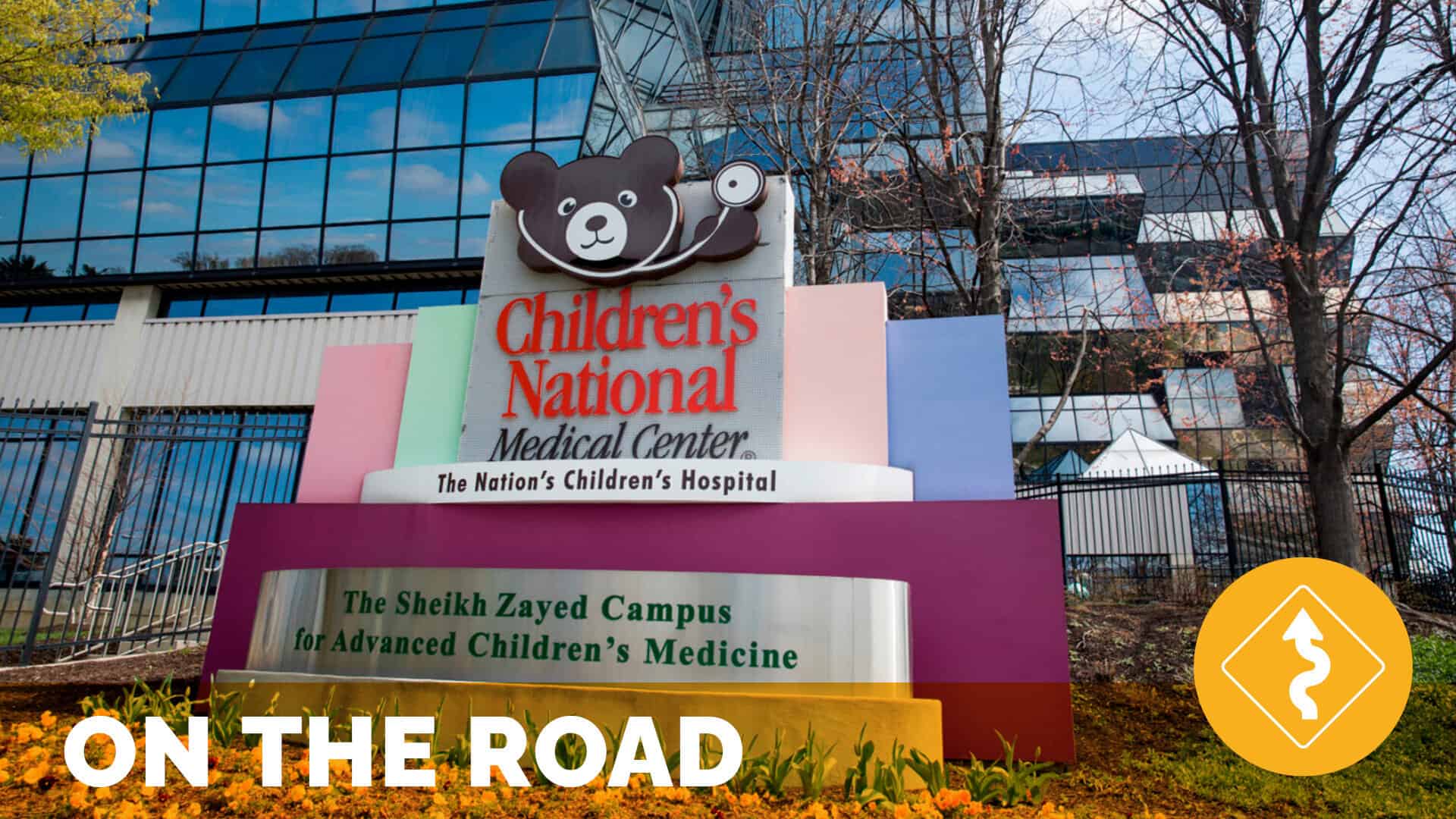The “Power of One”: Creating Excellence in Patient and Family Experience for Many

On the Road with Children’s National Medical Center – January 2012
by Jason A. Wolf
I had the honor to start our 2012 On the Road series at Children’s National Medical Center in Washington, DC. Children’s National is the only exclusive provider of acute pediatric care in the metropolitan Washington area, and is the only freestanding children’s hospital between Philadelphia, Pittsburgh, Norfolk, and Atlanta. It has operated for 140 years as a proven leader in the development and application of innovative new treatments for childhood illness and injury. Children’s National also plays a critical role in providing extensive primary care to a large number of the children in Washington, a community commitment that is central to its mission. Not just one healthcare facility, it is a network of centers and clinics that ensure a healthy infrastructure for the children in the region. With this powerful mission, I also discovered it to be a place that many people called home, a professional home that is. The tenure of the many I spoke with ranging over 20, 30 and even 40 years of service.
This explains how the tone for my visit was set well before I ever arrived, when the team gathered on the phone for our planning call. A first for an On the Road, a large number of staff from all corners of this impressive organization joined us in planning for the visit. The passion for their experience efforts was palpable and I was overwhelmed to discover on my arrival that people from across the organization, with the coordination of Vince Schuyler, Director of Quality & Community Partnerships at The Goldberg Center for Community Pediatric Health and Melissa Winter, Executive Director of Service Excellence, had come out in force to share the story of Children’s commitment to patient and family experience. The extensive nature of this visit cannot be done justice in a short article, but the incredible actions exemplified in the stories I will share represent an organization that seemingly lives and breathes experience at every interaction.
No HCAHPS Required – A Pure Commitment to the Patient & Family Experience
For most people who follow the information and stories from The Beryl Institute, it is hard to escape the discussion of the influence of healthcare reform, the Hospital Consumer Assessment of Healthcare Providers and Systems (HCAHPS), and value-based purchasing. As we wrapped up 2011, I too recognized our focus on the adult, acute care setting, much of this being driven by the very urgency of these programs. There is also increasing attention in the physician group setting with the emergence of new measures through CGCAHPS. This realization was important as the patient and family experience is not simply driven in those environments and as I have said before, our actions should not simply be motivated by policy alone.
It is that distinction that makes the commitment of organizations like Children’s National and other children’s hospitals all the more significant. They have made a fundamental decision in anticipation and recognition of real need and doing the right thing, not in response to any requirement. Many of these organizations lead the way in new ideas and practices for providing unparalleled patient and family experience. In speaking with Brenda Shepherd-Vernon, Executive Director of Family Services, this belief was validated. She noted that, “Patient and Family Experience has always been a part of our mission [at Children’s]. More importantly, in our setting we recognize that families are the decision-makers, they are the observers, and receivers of our experience as well.” This is a critical realization in the Children’s and Pediatric setting: that parents, family and/or caregivers are a central part of the overall experience. This adds a potential layer of complexity and a different level of opportunity. Melissa Winter reinforced this as a core operational philosophy (and you will see it exemplified in how Children’s National puts its mission into action). She shared, “To view patient experience as just the patient is not possible in our setting, we must actively engage family caregivers – parents, family members or guardians – as active players in the overall experience.” This means that the team at Children’s National has to think of Patient Experience as a 360-degree effort. Compared to some patient experience efforts, which may seem transactional in nature, the experience at Children’s National encompasses the many and sometimes complex dimensions around the whole healthcare experience. Brenda Shepherd-Vernon reinforced this by stressing that the job of staff members in every role and at all levels is to help families see and feel they have the authority in every experience. It is from this pure commitment and unique complexity found in the children’s and pediatric environments that powerful examples of practice emerged. It started with the power of one.
The “Power of One”
The “Power of One”is a central program at the foundation of Children’s efforts to drive the quality patient experience. Its simplicity is perhaps it strength. The “Power of One” effort is based on the premise that every individual in the organization has the ability AND the responsibility to impact the critical aspects of work in the facility including safety, clinical quality, service, and access. The program helps staff members understand their role and develop key skills in ensuring that their actions impact those four areas, which leads to a quality patient experience. In this model I found the definition of patient experiencewe share from the Institute brought to life – the sum of all interactions, shaped by an organization’s culture that influences patient perceptions across the continuum of care.
Mary Ann HilliardMary Ann Hilliard (left), Chief Risk Council, said, “The “Power of One” was a game-changer institutionally. It engaged people throughout the organization and gave them clear permission to be actively involved.” A key to the program, according to Melissa Winter, was its focus on very basic but important actions that influence safety, quality and service. Key shared lessons include processes such as peer checking, closed loop communication, effective handoffs, and even peer coaching. It also reinforces core expected behaviors such as picking up garbage when you see it on the floor, walking people to their destination, answering ringing phones, and introducing yourself to others.
Even before I had learned about The “Power of One”, I had a chance to see it in action. As I was waiting at the welcome desk to get my visitor’s pass on the morning of my visit, the line was growing with early arrivals for medical appointments, outpatient procedures, and family visits. As I was waiting, Pat Johnson, the Collaborative Practice Facilitator in Performance Improvement, was in the lobby and saw the line backing up. She knew the secondary registration desk had no line so she identified patients that were going to need to be in that part of the building, lead them off the line and escorted them to the other desk, lessening the wait time for all and leaving a powerful impression as well.
What was even more significant about The “Power of One” was the commitment it clearly had throughout the organization. Every Children’s employee took the course, meaning that more than 6,500 individuals – from housekeeping to the CEO, from engineering and researchers to every physician – learned, understood the requirements, and in essence “spoke the same language.” The service results are now being seen. New employees are immediately exposed to these concepts within their first two days of work and they are consistently reinforced through the very skills the program teaches – feedback and coaching, communication and engagement. What was significant to me about the program was what I shared in my December Blog that reinforced what was exemplified by the program – that every individual represents the patient experience. At Children’s National you could see this in the action of almost all that you encountered.
Leading with The “Power of One”
While I have often seen healthcare organizations talk a good game on these types of efforts, all too often you see leaders who do not reinforce accountability for action. From the powerful support of Mary Ann Hilliard, to new CEO Dr. Kurt Newman, leaders exemplify their commitment to this effort through their actions.
Debbie Freiberg, VP of Nursing, reinforced the importance of leadership in this effort. She shared that an important part of her role was to set strong expectations, support her staff as mentor, and ensure they have the tools they need to do their job. She added, “My staff satisfaction will lead to patient and family satisfaction.” How does she address this? First, by being present and available for her team. She takes the time to regularly visit her units and just recently came in on night shift to listen, engage and support. Debbie also reinforced the importance of engaging with patients and their families. She shared the story of how one day she was riding in the elevator and heard a young boy leaving after a series of cancer treatments say to his parents, “I can’t believe I won’t be able to come back here for two weeks [the time of his next treatment]. I love this hospital.” She ended up speaking with the patient and his family about his experience, simply asking what they could do to make visits even better. His response led to some new ideas for the clinic, namely the opening of a library on the unit for the children undergoing treatment. His idea was so powerful it even garnered a donor who supplied Kindles for the library so they could access even larger amounts of materials. All of this arose from a simple commitment to interaction.
Dr. Denice Cora-BrambleThrough my conversations I continued to encounter leaders across the organization who engaged in this way. I had an opportunity to speak with Dr. Denice Cora-Bramble (right), Senior Vice President,The Goldberg Center for Community Pediatric Health. The Goldberg Center is a multi-site, primary care offering and Level 3 NCQA Patient-Centered Medical Home for more than 30,000 children in Washington, DC. Dr. Cora-Bramble expressed that the work of patient experience was synonymous with The “Power of One” effort. She was emphatic in stating that this effort was not an initiative, but a key component of providing overall care. Starting with the critical nature of access in today’s healthcare system, Dr. Cora-Bramble supported the notion that patient experience was truly the sum of all the parts in the care continuum. She also reinforced the central role leadership has to place in supporting the success. Senior leaders of the organization now share a process called leadership on call. This is not simply standing by in case of an urgent need, but what is special about this effort is the requirement that leadership as Dr. Cora-Bramble said, “is present and palpable for the patients and staff.” Leaders come in and round during their on call periods, including nights and weekends to be available for the staff. The philosophy she shared is one modeled by CEO Dr. Kurt Newman of being present for families and for staff. This leadership visibility and support of the core elements of The “Power of One” are important elements in reinforcing its application and sustainability.
Engaged Physicians
One wild card in many patient experience efforts, and an area I am asked about often, is the engagement of physicians. What was amazing at Children’s National was not just one, but six physician champions (pictured below) spent time with me discussing their role in The “Power of One”. The doctors were not just those that were immediately on board with the program in the midst of their core clinical requirements. One individual was very open in saying that the experience she had during “Power of One”training had her rethink the impact she could have on experience overall. While begrudgingly attending the course, she came away thinking this is the way we must practice. Not only is this now part of her practice, she took additional training to be able to deliver the courses to others and now serves as a “Power of One” coach as well.
Physician Champions
What was powerful in the collective stories shared by the physician champions was the recognition of the value of linking excellence in practice with excellence in service. Dr. Rhonique Shields-Harris shared a thought that garnered emphatic agreement from the group, “Great care is not just about the treatment. As physicians we need to see ourselves as integral team members. We are not there to be dictators, but rather part of the overall experience team. There will be times we lead and times we will need to support.” Dr. David Stockwell added to this thought, as I inquired to the group about why they felt service was important. He said, “It is simply the right thing to do and enables us to focus on the right thing. As doctors we do not just write prescriptions or do procedures; if that is all we do we are failing our patients. We must recognize we too are in the service business.”
Dr. Cara BiddleI saw this effort having an impact as well in the primary care efforts embedded in Children’s National. Dr. Cara Biddle (left), Medical Director for the Children’s Health Centers shared the story of the organization’s effort to make healthcare accessible and supportive for all patients. By providing not only healthcare services, but also additional wrap-around services that support the totality of the health experience, Children’s National has also shown the ability to integrate The “Power of One” into the individual encounters of primary care. Efforts to establish and then being recognized as the first NCQA Level 3 Patient Centered Medical Home reinforced Children’s commitment to the overall experience. This extensive service offering also represented Children’s commitment to the community it serves, exemplifying that the patient experience extends from well before to well after the clinical encounter itself.
Seeing The “Power of One” at work in the extended corners of the organization, not just as a training program, but as expected behavior from leadership, from doctors and throughout the organization reinforced the commitment to a simple, yet extensive effort to ensure a quality patient experience at Children’s National. I had the opportunity to visit a number of units and to engage with unit heads, department directors, charge nurses and staff. There was a consistent recognition of the responsibility each of these individuals had to the care AND the service they provided. This was a powerful foundation on which to build a commitment to experience, and it was clear in all parts of the organization this effort was in action. While The “Power of One” program guided behaviors, Children’s National also was committed to very visible and active services to reinforce the framework needed to support excellence in patient experience overall.
A Framework for Patient and Family Experience
While many healthcare organizations may have tried, and even successfully implemented some of these components of a patient experience infrastructure, I wanted to highlight some of the efforts that, while perhaps familiar, took on a unique form and seemed to significantly impact Children’s efforts overall. A selection of volunteers and leaders (pictured below) took the time to share a number of their core programs.
Patient Family Advisory Council (PFAC). The vision of the PFAC is to ensure that each patient or family member at Children’s National is empowered, respected, and honored by including their voices throughout the care delivery process. The powerful examples I saw in action were the role that members of the PFAC had at a global level, as well as the fact that many units engaged a unit or department level PFAC to address issues. The PFACs are not only nice-to-have entities, but also are active participants in the efforts and direction of the organization. They participate in the planning and design for new units under construction, offer suggestions and drive changes for the facility, such as restroom renovations, and processes, such as discharge process redesign. They also recognize units for their commitments to patient centered care. Finally they are part of the line-up of facilitators at New Employee Orientation, where they reinforce through stories from patients and their families, the importance of a continuous focus on service and experience.
Concierge Services. These services, while typically found in many other healthcare organizations, took on extended meaning at Children’s National. Many of the major units have a concierge in place to support parents and families. The program provides personalized services to families and works to remove non care-related stressors that parents encounter when their children are ill. The network of concierges ensures parents can focus their attention on their children’s medical needs. The Children’s Concierge program assisted more than 7500 families and other guests in 2011 (which equates to more than 20 individuals or families a day). This program is a service to the families and caregivers, and also alleviates the need of staff to play this role so they can focus on bedside and clinical care.
Parent Navigators. Again, note the focus here on parents or caregivers. Children’s National has a team of full-time and part-time navigators focused especially on those parents who have a child with special needs or a chronic condition. Unlike patient navigators, parent navigators are parents themselves with special needs children who traveled many of the paths other parents may be taking for the first time. They serve as resources for information, understanding the system, managing the personal and emotional aspects that can come with having, as the program describes, “exceptional children.” The program seeks to inform, educate, support and empower families in the care experience.
Parents Letter Project.(http://www.aparentsletter.com) This is a program through which parents that have had care experiences at Children’s National can write a letter that can be shared with others. Parents encountering a situation for the first time can search out these letters to learn more and be better prepared for their care experience.
As I discovered these special services offered at Children’s National, I was amazed by the consideration, time, energy and resources committed to the patient and family experience through these efforts. These variations on common programs found in many adult hospital settings should raise significant questions about how hospitals and other healthcare organizations can focus with greater intention on all elements that comprise the overall experience. There are some simple, yet important lessons to be learned.
A Vision for the Child (in all of us)
My visit to Children’s National Medical Center was epitomized in many ways by the efforts staff members make to go the extra mile. The tremendous number of people who spent time sharing their stories or showcasing their programs was amazing. It is this commitment to a welcoming environment that at its core represents the possibilities of the power of one in any patient experience effort. While I could not write about each encounter or every individual that gave the gift of their time and insight, the collective picture the emerged from this On the Road was impressive. We have a great opportunity to learn from the efforts of those taking care of some of the most important people in our lives, our children.
In fact, the commitment is so strong to this idea that Children’s National worked with their Patient Family Advisory Council to describe what families and children want from their experience. They call it their Child Centered Vision. It reads:
My hospital is a bright and happy place that feels like home.
My providers, my family, and I are a team, and everyone’s job is important.
The way my hospital works is built around me.
My providers don’t all look alike.
My hospital is my family’s connection to everything I need for my health, whether they provide it or blaze a trail to it.
Perhaps I should have started with sharing these words, because they represent the way you feel when connecting with the people of Children’s National. For a place that could be considered scary to children and frightening to their parents or caregivers, the team at Children’s National has created something different for patients and families – a place that feels like home, a place where you are part of the team, a place where you are central to the process, a place where your differences are appreciated, and a place where your needs are met without question. That is a powerful commitment to patient and family experience for the many, based on the power of one.
Welcome to Children’s National Medical Center
Special thanks again for Vince Schuyler for the gracious invitation and the incredible effort to bring together a world-class team of healthcare leaders and caregivers. To all those that shared your stories: Thank you for the gift of your passion, knowledge and experience.
Related content
-
 Patient Family & Community Engagement
Patient Family & Community EngagementPX Chat on PFA/PFACS: New/Getting Started (August 6, 2025)
12pm ET / 11am CT / 10am MT / 9am PT – Join The Beryl Institute community for an opportunity to connect with your peers on the support and resources needed to address efforts around new and getting started with PFAs and PFACs in their organizations. Breakout discussion groups allow you to share your challenges,
Learn more -
 Patient Family & Community Engagement | Quality & Clinical Excellence
Patient Family & Community Engagement | Quality & Clinical ExcellenceWhat Healthcare Providers Need to Know About Newcomer Health Equity
Newcomers are a vital yet often misunderstood segment of the population that healthcare providers serve. This webinar explores the landscape of newcomer health equity in Canada and the United States, offering valuable insights into the challenges faced by this vulnerable group. Attendees will gain a deeper understanding of the various categories of newcomers in each
Learn more -
 Patient Family & Community Engagement
Patient Family & Community EngagementPatient Experience (PX) Giants: Pioneers and the Path Forward
This commentary pays tribute to the foundational figures in patient experience (PX) scholarship, acknowledging the “PX Giants” whose contributions have established and expanded the field’s core principles. Building upon the analysis in Foundational PX, which identified highly cited works, this piece honors individual contributors who have contributed to the scholarly foundation of PX. It highlights
Learn more
